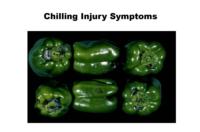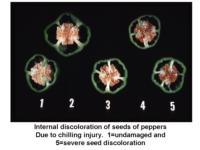Postharvest Handling and Storage
Peppers should be cooled as soon as possible to reduce water loss. Peppers stored above 7.5°C (45°F) suffer more water loss and shrivel. Storage at 7.5°C (45°F) is best for maximum shelf-life (3-5 weeks); peppers can be stored at 5°C (41°F) for 2 weeks, and although this reduces water loss, chilling injury will begin to appear after that period. Symptoms of chilling injury include pitting, decay, discoloration of the seed cavity, softening without water loss. Ripe or colored peppers are less chilling sensitive than green peppers.
| Temperature | 5°C (41°F) | 10°C (50°F) | 20°C (68°F) |
| ml CO2/kg·hr | 3-4 | 5-8 | 18-20 |
To calculate heat production multiply ml CO2/kg·hr by 440 to get BTU/ton/ day or by 122 to get kcal/metric ton/day.
Bell Peppers respond very little to ethylene; to accelerate ripening or color change, holding partially colored peppers at warm temperatures of 20-25°C (68-77°F) with high humidity (>95%) is most effective.
>95%; firmness of peppers is directly related to water loss
Bell peppers are nonclimacteric in behavior and produce very low levels of ethylene: 0.1-0.2 µl/kg·hr at 10°C-20°C (50°F-68°F).
Peppers generally do not respond well to CA. Low O2 atmospheres (2-5% O2) alone have little effect on quality and high CO2 atmospheres (>5%) can damage peppers (pitting, discoloration, softening) especially if they are stored below 10°C (50°F). Atmospheres of 3% O2 + 5% CO2 were more beneficial for red than green peppers stored at 5°C (41°F) to 10°C (50°F) for 3-4 weeks.
Temperature & Controlled Atmosphere Photos
Disorders
Blossom End Rot. This disorder occurs as a slight discoloration or a severe dark sunken lesion at the blossom end; it is caused by temporary insufficiencies of water and calcium and may occur under high temperature conditions when the peppers are rapidly growing.
Pepper Speck. This disorder appears as spot-like lesions that penetrate the fruit wall; cause is unknown; some varieties are more susceptible than others.
Chilling Injury. Symptoms of chilling injury include surface pitting, water-soaked areas, decay (especially Alternaria), and discoloration of the seed cavity.
Mechanical damage. (crushing, stem punctures, cracks, etc.) This is very common on peppers; physical injury not only detracts from the visual quality of the peppers but also causes increased weight loss and decay.
On California-grown bell peppers, the most common decay organisms are Botrytis, Alternaria, and soft rots of fungal and bacterial origin.
Botrytis or Grey mold decay. This is a common decay-causing organism on peppers; field sanitation and prevention of wounds on the fruit help reduce its incidence. Botrytis will grow well at the recommended storage temperatures. High CO2 levels (>10%) which can control Botrytis damage peppers. Hot water dips of peppers can effectively control Botrytis rot (55°C [130°F] water for 4 minutes) without causing fruit injury.
Alternaria Rot. The presence of black Alternaria rot, especially on the stem end of the pepper is a symptom of chilling injury; best control measure is to store at 7.2°C (45°F).
Bacterial Soft Rot. Soft rotting areas can be caused by several bacteria which attack damaged tissue; soft rots can also be common on washed or hydrocooled peppers where water sanitation was deficient.
[For more information, see our publication “ Fruit Ripening & Ethylene Management ”, available for purchase using our Publication order form .]

















